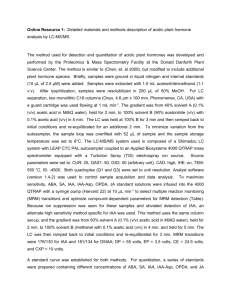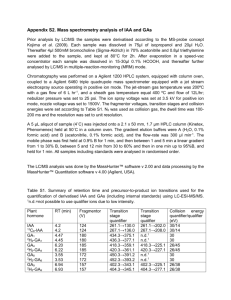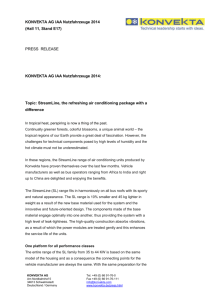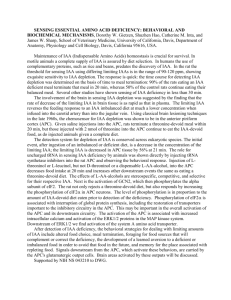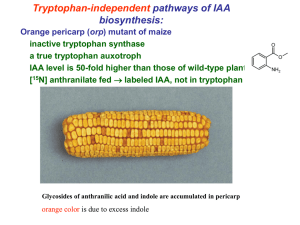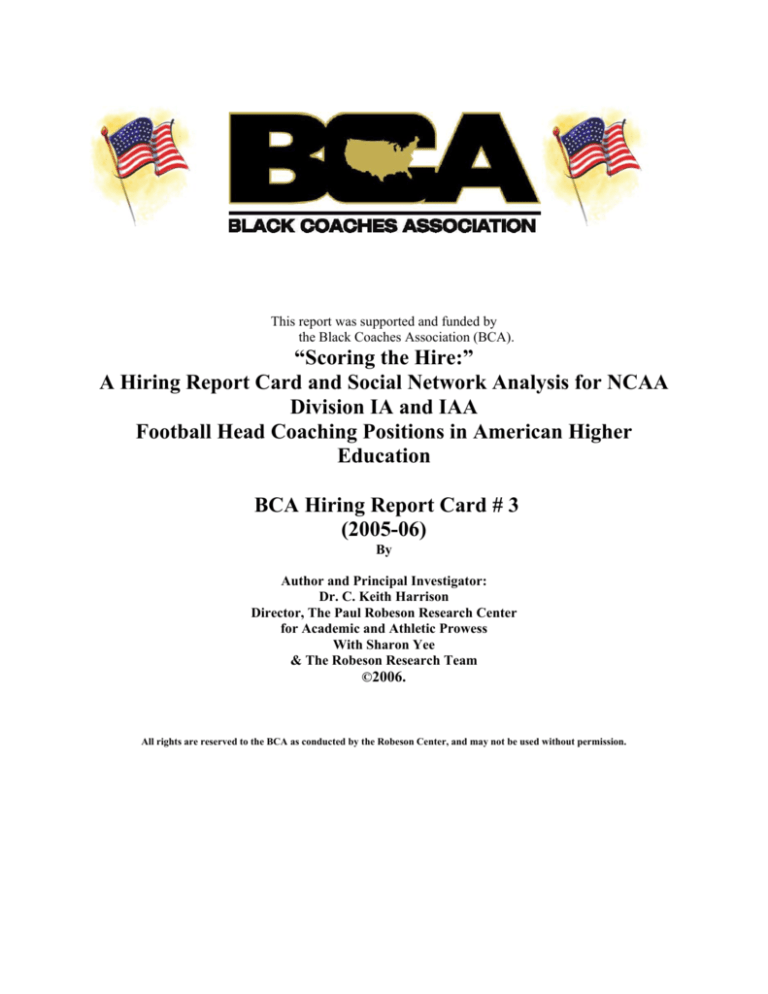
This report was supported and funded by
the Black Coaches Association (BCA).
“Scoring the Hire:”
A Hiring Report Card and Social Network Analysis for NCAA
Division IA and IAA
Football Head Coaching Positions in American Higher
Education
BCA Hiring Report Card # 3
(2005-06)
By
Author and Principal Investigator:
Dr. C. Keith Harrison
Director, The Paul Robeson Research Center
for Academic and Athletic Prowess
With Sharon Yee
& The Robeson Research Team
©2006.
All rights are reserved to the BCA as conducted by the Robeson Center, and may not be used without permission.
DISCLAIMER
The Paul Robeson Research Center for Academic and Athletic Prowess, the University of Central
Florida and any other institution that assisted with this study are not liable for any implications or
ramifications based on the results of the study. While the research design was conducted for the Black
Coaches Association (BCA) Hiring Report Cards (HRC) by the Robeson Center, the content of the design
has been a collaborative effort of the past BCA sponsored Summits for Equity in Hiring (2001-2006) and
the Robeson Center. This group is comprised of representatives of the Black Coaches Association, the
NCAA, selected athletic administrators, conference commissioners and other recognized sport
professionals. The BCA’s purpose in conducting this study in partnership with the Robeson Center is to
objectively analyze the data that was provided (or not provided) by each of the institutions and all nonscientific issues related to the study should be addressed with the BCA.
ii
Cover Content & Photography:
The Black Coaches Association is a 501 (c) (3) tax exempt non-profit organization whose primary
purpose is to foster the growth and development of ethnic minorities at all levels of sports both nationally and
internationally. The BCA is committed to creating a positive enlightened environment where issues can be
examined closely, debated sincerely and resolved honestly. The BCA's focus involves the concerns of its
colleagues in professional sports, all levels of the NCAA, junior college and high school. The BCA is committed
to creating a positive enlightened environment where issues can be examined closely, debated sincerely and
resolved honestly.
•
•
•
BCA Mission Statement:
To address significant issues pertaining to the participation and employment of minorities in sport
in general and intercollegiate athletics in particular.
To assist minorities aspiring to have a career in athletics through educational and professional
development programming and scholarships.
To provide youth and diverse communities the opportunity to interact positively with the BCA as
a corporate citizen and community builder through a variety of alliances.
If one realistically and objectively views the landscape of this issue; it would be safe to conclude that one
or both of the following must occur in some significant form to realize significant increases in the hiring
ratio of head football coaches of color on the intercollegiate level. We will need to experience an increase
in the social consciousness levels of the ethnic minority student-athletes attendance decisions based on
part by diversity and inclusion; and/or the realization of legal implications of Title VII in the
intercollegiate hiring process—Floyd Keith, Executive Director, Black Coaches Association
Robeson Research Team:
Principal Investigator and Lead Author:
C. Keith Harrison
Project Manager:
Sharon Yee
Research Design and Data Analysis:
C. Keith Harrison and Sharon Yee
Research Assistants
Graduate Assistants: Quaylan Allen, Robert J. Alridge II, Will Broussard, Desiree Serrano, and Elliot
Sharpe
Research Assistants: Vashti Rulland
iii
TABLE OF CONTENTS
Page
Robeson Research Center Team…………………………………………………………..……..iii
FOREWORD…………………………………………………………………………………….v
Executive Summary……………………………………………………………………..…….....vi
Highlights of Past Three Years…………………………………………………………………...vii
METHODOLOGY……..…………………………………………….….……………………….1
Data Collection……………………………..………………………….….…..………….1
Respondents…………..………………………….….…..…………………………….….1
Measurements……………………………………………….…….………………….…..2
FINDINGS and RESULTS……………………….……….……………………………….…….5
Discussion………………………………………………………………………….…….8
CONCLUSION…………………………………………………………………………….…....10
Limitations ……………………………………….………………………..….................10
Policy Recommendations and Future Research………………………………………....11
REFERENCES………………………………………………………………………………….13
APPENDIX
A.
Comparison of Years 1, 2, and 3………………………………………………..15
B.
Final Grades and Grade Breakdown by School Year 1……………….………...16
C.
Final Grades and Grade Breakdown by School Year 2…………………………17
D.
Final Grades and Grade Breakdown by School Year 3…………………………18
E.
Review of Literature: Social Network Theory and Title VII…………..……….19
ACKNOWLEDGEMENTS………………………………………………………………………21
BIOGRAPHIES ………………………………………………………………………….………21
TABLES
1.
Final Grades by School and Division for 2005-06 Report #3…………………….ix
2.
Final Grade for All Schools by Division……………………………………..…5
3.
Grade Composition for “A” Schools………………………………………..…..6
4.
Grade Composition for “B” Schools………………………………………..…..7
5.
Grade Composition for “C”, “D”, and “F” Schools………………………….....8
FIGURES
1.
Research Design Diagram for Hiring Report Card……………………………….4
iv
Foreword— by Richard E. Lapchick, Ph.D. Known as the “racial conscience” of sport in society. A
former student-athlete on the basketball team at St. John’s University, Professor Lapchick has truly
“changed the game” and offered these words on the eve of the Third Annual Hiring Report Card of
NCAA college football head coaching positions.
This is the third year that the Black Coaches Association Hiring Report Card places the hiring process of
institutions of higher education in their search for a new head football coach under public scrutiny. The
BCA after three years have objectively changed the way we see head coaching positions in America.
Last year was the worst of the three years the BCA Hiring Report Card. This year’s grades are better in
some areas than the first two years—but worse than ever in other areas.
The BCA is seeking changes in the way we hire head coaches in football. We want the best candidates,
irrespective of color, to be interviewed for the opening. The Black Coaches Association Hiring Report
Card is helping to make that happen. Next, the BCA wants the best candidate to be chosen irrespective of
race. With only five African-American head coaches in the 2005 season, college football is emphatically
the most segregated position in all of college sport. There still have been only 21 African-Americans who
have ever been a Division IA head football coach and opportunities have been limited at other levels of
competition such as Division IAA, II or III.
As can be seen from the grades in the report card, schools received an “A” without hiring a coach of color
because they took their time in the selection process, had a diverse selection committee, interviewed a
diverse pool of candidates, used the resources of the BCA and/or the NCAA’s Minority Opportunities and
Interest Committee, and followed university affirmative action policies. This year for the first time, you
cannot earn an overall “A” if you get a D or F in any of the five categories. Also, for the first time a
school is rewarded for the outcome of hiring a coach of color with “bonus” points, making the report card
a measure of both the process and the outcome.
The BCA believes in that open and objective process because we know that ultimately, when it is
followed, the numbers will change automatically as universities come into contact with talented leaders
who could be their next football coach. It has my hope that the NCAA will adopt a college version of the
NFL’s Rooney Rule mandating that people of color be interviewed for all head coaching positions.
I applaud the Black Coaches Association for standing up and taking this action now. I am pleased that the
BCA will also issue a hiring report card on athletics directors and women’s basketball coaches in 2007. I
am proud to be the first Vice President of the BCA. The fact that I am white and a BCA 1st Vice President
further shows what the BCA is all about.
Once again, Dr. C. Keith Harrison, Sharon Yee and their research team at the Robeson Institute, did an
excellent job of initiating the research, following through with the universities, and putting forth an
objective analysis of where we are today, The 2006 Report holds schools accountable in one of sports
most inequitable situations! I congratulate the BCA and the work of the Robeson Institute to achieve this
outstanding and practical research effort. The 2006 Report will make a difference.
Richard Lapchick, Ph.D.
Director, DeVos Sport Business Management Program
President, National Consortium for Academics and Sport
Director, Institute for Diversity and Ethics in Sport
University of Central Florida
v
“That someone qualifies for a job should not be equated with meriting it, where merit is understood as a
moral entitlement to the job.”— Dr. Amy Guttman
Executive Summary
Since 1982, there have been 414 head coaching openings at the Division IA level. African-American
coaches have been selected for 21(5 percent) of the head coaching opening with 19 of the appointments
occurring after 1990 (Harrison & Yee, 2006; Hill, 2005; Lapchick, 2005). In the history of Division IA,
African-American coaches have been selected a total of 25 times as the leaders of college football
programs (Harrison & Yee, 2006; Hill, 2005; Lapchick, 2005). Since 1996, only 11 African-American
coaches have been hired (one each year with the exception of this year) out of 175 vacancies (6 percent).
The same historical pattern of Division IA football is even less diverse at the Division IAA, II, and III
levels. This year, while there are nearly 100 predominately white IAA schools that compete in football,
only six are head coaches of color.
In the 2005-06 Hiring Report Card #3, the grades both improved and reached new lows in terms of the
overall letter grades in certain categories. Further, when each of the five categories of the Hiring Report
Card is examined, low marks across the categories empirically indicate the need for more improvement in
the various areas. Consider the following snapshot of the overall marks and the five hiring categories:
Overall Final Grades
There are a total of 26 schools in the study. Sixteen are IAA and ten are IA. There are 12 “A,” three “B,”
two “C,” three “D,” and six “F” grades for the IA and IAA schools. All six of the “F” grades are
automatic as they did not turn any data in for the study. Overall grades for IA are as follows: four “A,”
one “B,” one “D,” and three “F” grades. The overall IAA final grades are as follows: six “A,” four “B,”
one “C,” two “D,” and three “F” grades.
IA Grading Category Breakdown:
Communication— seven “A” and three “F” grades in this area.
Search Committee— three “A” and two “B,” and five “F” grades in this area.
Final Candidates— four “A,” two “B,” and four “F” grades in this area.
Time Frame—four “A,” three “B,” and three “F” grades in this area.
Affirmative Action— four “A,” one “B,” two “C,” and three “F” grades in this area.
IAA Grading Category Breakdown:
Communication— 12 “A,” one “B,” and three “F” grades in this area.
Search Committee—five “A,” eight “B,” and three “F” grades in this area.
Final Candidates— nine “A,” two “B,” and five “F” in this area.
Time Frame—14 ”A” grades and two “F” grades in this area.
Affirmative Action—six “A,” two “B,” six “C,” and two “F” grades in this area.
Overall Grading Category Breakdown:
The most significant findings this year of the five grading categories are Time Frame and Candidates
Grade. In both of these categories, at least half of the schools earned an “A” grade. When grades of
“A” and “B” are included, four of the five categories have over half of the schools earning either an “A”
or “B” grade. The results show the significance of having a diverse search committee. The only grading
vi
component that does not have at least half of the schools earning an “A” or “B” is the search committee.
The 26 searches had a total of 134 individuals participate on the search committee. Of those 134
individuals, 34 were racial minorities. Our findings show that for each person of color on the search
committee, the number of racial minority candidates interview increases by 0.5 (half a person) regardless
of division (significant at the .05 level, sig.=.024). For each minority on the search committee, the
numbers of both the interactions with the BCA increased (b=1.070 which is sig. at the .01 level; sig.=
.005) respectively. Likewise, for each interaction with the BCA, the number of minority candidates
increases by .751 (statistically significant at the .10 level, sig.=.097). This year’s data also showed that
for each minority on the search committee, the length of time that the hiring process took increased by 9.4
days which was statistically significant (sig. at the .05 level; sig=.012).
Highlights of Past Three Years (2003-2006)
The studies of the past three years show the remarkable turnover of Division I football coaching vacancies
with 40 percent in Division IA and IAA football combined (40 percent in Division IA and 38 percent in
IAA). In the three years of the BCA HRC, a total of 84 schools have been graded which is 35 percent of
the schools. There have been a total of 47/119 IA schools graded (40 percent). The University of Idaho
has been graded twice in the three years of the report cards. There have been a total of 37/98 IAA schools
graded (38 percent). Elon, Fordham, Idaho and The Citadel have all been graded twice.
Currently there are five coaches of color at Division IA schools and six coaches of color at Division IAA
schools. They are:
Name
Institution
Division
Race
Sylvester Croom
Mississippi State
IA
Black/African-American
Karl Dorrell
UCLA
IA
Black/African-American
Turner Gill
University of Buffalo
IA
Black/African-American
Ron Prince
Kansas State
IA
Black/African-American
Tyrone Willingham
Washington
IA
Black/African-American
Stacy Adams
Valparaiso
IAA
Black/African-American
Tony Samuel
Southeast Missouri State
IAA
Black/African-American
Jerome Souers
Northern Arizona
IAA
American Indian/Native American
Chris Taylor
St. Peter’s College
IAA
Black/African-American
Lou West
Indiana State
IAA
Black/African-American
Norries Wilson
Columbia
IAA
Black/African-American
Source: NCAA Office of Diversity and Inclusion, 2006
When looking at the past three years of the study, the following snap shot is painted. The highest
percentage of schools, regardless of division, earned an “A” grade. However, this represents only (33)
38.8 percent of the sample, which is well below half. However, when combined with the amount of
schools who earned a “B” final grade (24) (28.2 percent), over half (57) (67 percent) of the schools earned
either an “A” or “B” grade. Conversely, (27) 31.8 percent of the schools did not earn at least a “C” grade
which is below par in terms of proactive diversity (see BCA HRC #1/2 for a description of what par is),
with the majority of these same schools (12) below par earning an “F” grade (14.1 percent).
When different grading components are taken into consideration, the following findings make the three
years of the reports clearer. The average number of minority candidates provided with an on-campus
interview in all three years, regardless of division, was 1.35 and the average number of total candidates,
regardless of racial/ethnic composition, provided with an on-campus interview was 4.48. This means,
that the average grade for search committee was an “A” grade. The average number of total search
committee members was 6.22 and the average number of minority search committee members was 1.57.
vii
This means that the average grade for the Search Committee Component was a “B” grade. Our findings
indicate that for each person of color on the search committee, the number of racial minority candidates
interviewed increases over the three year span by .177 regardless of division (significant at the .01 level,
sig.=.010).
For more information, past reviews of the literature and theoretical framework analyses for the Hiring
Report Cards, Year 1, 2, and 3 please go to www.bcasports.org and see appendix.
viii
Table 1: Final Grades by School and Division Chart and Graph for 2005-2006 Report #3
Final Grades for All Schools by Division Affiliation
School Name
Division Affiliation
Boise State University
IA
Kansas State University**
IA
Middle Tennessee University
IA
Rice University
IA
San Diego State University
IA
Temple University
IA
University of Buffalo**
IA
University of Colorado
IA
University of Idaho
IA
Wisconsin University
IA
Butler University
IAA
Central Connecticut State University
IAA
Columbia University**
IAA
Elon University
IAA
Fordham University
IAA
Georgetown University
IAA
Georgia Southern University
IAA
Hofstra University
IAA
Lehigh University
IAA
Liberty University
IAA
Missouri State University
IAA
Murray State University
IAA
Southeast Missouri State University**
IAA
Stony Brook University
IAA
University of Northern Colorado
IAA
Virginia Military Institute
IAA
**Indicates the school hired a non-white coach or person of color
Final Grades for all Schools by Division
A
B
C
D
Final Grade
F
B
A
F
A
A
A
D
C
F
B
C
A
D
A
A
F
A
A
F
F
A
A
A
B
D
F
Division IA
4
1
1
1
3
Division IAA
8
2
1
2
3
12
3
2
3
6
Total
Note: Northwestern University was not graded. Source: Paul Robeson Research Center for Academic and
Athletic Prowess, 2006
ix
Methodology
Data Collection
Floyd Keith, the Executive Director of the BCA, sent a standard package each time there was a
documented head football coach opening. He contacted the athletic director and president at each of the
individual institutions with an official letter to inform them that principal investigator, Dr. C. Keith
Harrison from the Paul Robeson Research Center for Academic and Athletic Prowess, would evaluate
them on five criteria (see Figure 1). A research team at the Robeson Research Center collected the data
from February to September, 2006 from each predominantly white institution. Harrison then sent out a
follow up letter that lists the evaluation content and criteria in February and March, 2006 (see Figure 1).
Thus, all institutions knew what they would be evaluated on and specifically by what criteria. Schools
either e-mailed, faxed, or mailed in their information to the Robeson Center. This year there were a total
of 6 “F” grades. Five of those six schools refused to participate.
Before the final data analysis was completed, a confirmation letter was sent to each school. The
confirmation letter listed the data that was already collected, and was sent to confirm accuracy and
verification. Each school had the opportunity to make necessary corrections to the data the researchers
compiled. The signature of both the president of the university and the athletic director were required on
the confirmation letter. Schools were given a two-week time frame to either make changes or confirm the
accuracy of the data. Eighteen of the 26 schools responded to confirm their data.
Respondents
There were a total of 26 schools that participated in the study based on the policy of the BCA
Task Force that not to participate is to participate. Twenty of the schools mailed in their data. Schools
were divided into those from Division IA and IAA. There were ten Division IA and 16 Division IAA
schools. Table 1 lists the institutions included in this study categorized by divisional affiliation. All
schools were graded and evaluated.
1
Measurements
Each school was graded on five categories: Communication, Hiring/Search Committee,
Candidates Interviewed, Reasonable Time, and Affirmative Action. Each school was asked specific
questions for each of the five categories. Each category has a numerical score that was converted into a
letter grade for presentation purposes. Each numerical score is used in the computation of the final grade
(see Figure 1). This year schools who hired a coach of color received a two point bonus to their final
score.1
Communication
Each school is measured on the number of direct telephone communications with the Executive
Director of the Black Coaches Association (BCA) and/or the Chair of the Minority Opportunity Interests
Committee (MOIC). If an institution has two or more communications, they earn an “A.” If there is one
communication, they earn a “B,” and no communications results in a “F.” Once the letter grade is
determined, it is coded into a numerical score, which corresponds as follows: “A”=four, “B”=three, and
“F”=zero. These numerical scores are used to compute the final grade.
Hiring/Search Committee
The Hiring/Search Committee2 measurement consist of two components. The first component is
the number of people of color on the search committee. The second component is the total number of
members of the hiring/search committee. The number of people of color is divided by the total number of
members on the search committee. That ratio is converted into a percentage by multiplying it by 100.
After the percentage of people of color on the search committee is determined, it is then converted into a
letter grade which adheres to the following grading scale: “A”= 30 percent or above people of color on
the search committee; “B”= 20-29 percent people of color; “C”=10-19 percent people of color; F”= nine
percent or less people of color on the search committee. Once the letter grade is determined, it is coded
1
2
This bonus affected the final grade of one qualifying school by slightly one letter grade.
Some institutions called their search committee advisory boards.
2
into a numerical score, which corresponds as follows: “A”=four, “B”=three, “C”=two, and “F”=zero.
These numerical scores are used to compute the final grade.
Candidates Interviewed
The Candidates Interviewed category is measured similarly to the way the Hiring/Search
Committee is measured. The numbers of candidates of color who earn an on campus interviews are
recorded. This total is divided by the total number of candidates, yielding a ratio of candidates who are
people of color to total candidates with on campus interviews. After the percentage of people of color in
the candidate pool is determined, it is then converted into a letter grade which adheres to the following
grading scale: “A”= 30 percent or more of people of color in the candidate pool; “B”= 20-29 percent of
people of color; “C”=10-19 percent of people of color; “F”= nine percent or fewer of people of color in
the candidate pool. Once the letter grade was determined, it was coded into a numerical score, which
corresponds as follows: “A”=four, “B”=three, “C”=two, and “F”=zero.
Reasonable Time
The duration of the search and hiring process is recorded and graded. This measurement is made
objective by examining previous patterns of head coaching hiring decision time frames by experts in the
hiring process of head football coaches. The grading category for a reasonable time is as follows: “A”=
two weeks or longer to make a final decision, “B”=six to13 days, “C”=four to five days, “D”= two to
three days, and “F”=one day or less to make a decision. When more time is allowed during the search
process, more potential applicants become aware of the open position and the search committee has the
chance to seek out additional candidates. Thus, a longer hiring process can help to ensure that the most
qualified candidates are able to apply, which is why longer time frames earned higher grades.
Affirmative Action
The affirmative action hiring policies and procedures for each institution were requested.
Researchers critically evaluate the level of documentation of affirmative action hiring policies and
procedures the institution has. Since the evaluation of the policies and procedures is open-ended, double
3
Figure 1: Research Design Diagram for the Hiring Report Card
Number of
communications
with BCA and/or
MOIC regarding
candidates of
color
Number of people
of color on hiring
committee/ Total
number of people
involved in hiring
process
Number of
candidates of color
provided with an
official interview/
Total number of
official interviews
Reasonable time
frame for search
and hiring process
Adherence to
Institution’s
Affirmative Action
Hiring Policies
A=2 Communications; B=1
Communications; F=0 Comm.
A=4 points, B=3 points, F=0 points
A=30%or higher, B= 20-29%,
C=10-19% , F=below 9%
A=4 points, B=3 points, C=2
points, F=0 points
A=30% or higher, B=20-29%
C=10-19%, F=9% or below
A=4; B=3 points; C=2 points;
F=0 points
Final Grade
Point Totals
A=18-20,
B=16-17,
C-14-15,
D=12-13,
F=11 or less
A=Over 2 weeks, B=6-13 days,
C=4-5 days, D=2-3 days, F=1 day
A=4 points, B=3 points, C=2
points, D=1 point, F=0 points
A=Completely, B=Mostly,
C=Halfway, D=Somewhat,
F=Not at all
A=4 points, B=3 points, C=2
points, D=1 point, F=0 points
BONUS: For schools that hired a coach of color, a two point
bonus will be added into the final grade point total.
© BCA conducted by the Robeson Research Center, 2003, 2005, 2006
blind evaluations are conducted to ensure accuracy and prevent biases. Each institution earn a letter grade
for their documented compliance with the affirmative action policies and procedures based on the
following grading scale: “A”= highly detailed level of documented policies and procedures; “B”= a more
than standard statement documenting the policies and procedures for affirmative action; “C”= a standard
4
policies and procedures document that said the institution does not discriminate; “D”= a somewhat
detailed documentation of the policies and procedures; “F”= no documentation of the policies and
procedures at all.
Final Grade
Once the letter grade is determined for each institution, it is then converted into a numerical score
based on the following scale: “A”=four, “B”=three, “C”=two, “D”=one, “F”=zero. These numerical
scores are used to compute the final grade. The final grade is computed by summing all of the
numerical scores for each of the five categories. The higher the numerical score (a total of 20
final numerical score points was possible), the better the letter grade. Once the final numerical
score is calculated, it is converted into a letter grade. The final grading scale is as follows:
“A”=18-20 final points; “B”=16-17 final points; “C”= 14-15 final points; “D”= 12-13 final
points; “F”= 11 or less final points.
Findings and Results
Table 2: Final Grades for all Schools by Division
A
B
C
D
F
Division IA
4
1
1
1
3
Division IAA
8
2
1
2
3
12
3
2
3
6
Total
Source: Paul Robeson Research Center for Academic and Athletic Prowess, 2006
When the divisions are compared (see Table 2), Division IAA does better overall. Forty percent
of the Division IA schools earned an “A” and thirty percent “F” grade. On the other hand, the majority of
the Division IAA schools earned an “A” or “B” grade (58 percent) where as fewer (42 percent) earned
failing grades. However, it should be noted that there are more head coach openings in Division IAA
than there are in Division IA.
5
Schools with an “A”
Twelve out of 26 total schools earned an “A” final grade. Four of these schools were Division IA
and eight were IAA. Of those who earned an “A” as an overall grade, the majority had grades of an “A”
in all of the categories (see Table 3). All schools earned an “A” grade in the communication component.
No schools received an “F” or a “D” in any of the grading categories. Time frame and communication
had the best grades with only one school in each category earning a “B” grade and all others earning an
“A” grade. Only four schools had a grade other than an “A” in the Affirmative Action category, which
means that (eight) 60 percent of the schools earned an “A.”
An overall “A” indicates that the institution is actively seeking the best people for the position,
including people of color who meet the schools’ job description criteria. Although it is possible for all
institutions to achieve a perfect score, which is what an institution should strive to achieve as Cornell
University, Western Michigan, and Ohio University have done in previous years, only two institutions
earned a perfect score this year: The University of Buffalo and Southeast Missouri State University. Both
of these schools will receive a certificate to congratulate them on their commitment to diversity.
Table 3: Grading Breakdown for “A” Schools
School/Division
Columbia - Div. I-AA
Fordham - Div. I-AA
Georgetown - Div. I-AA
Hofstra - Div. I-AA
Lehigh - Div. I-AA
Middle Tenn. State - Div. I-A
Murray State University - Div. I-AA
San Diego State University - Div. I-A
Southeast Missouri State - Div. I-AA
Stony Brook - Div.-IAA
Temple University - Div. I-A
University of Buffalo - Div. I-A
Time
Frame
A
A
A
A
A
A
A
B
A
A
A
A
Communication
Points
A
A
A
A
A
A
A
A
A
A
A
A
Final
Candidate
A
A
A
A
B
B
A
A
A
A
A
A
Source: Paul Robeson Research Center for Academic and Athletic Prowess, 2006
6
Search
Committee
B
A
B
B
B
A
A
B
A
A
A
A
Affirmative
Action
A
C
A
A
A
A
C
A
A
B
C
A
Schools with a “B”
Three out of 26 schools also have a “B” as a final grade (see Table 4). A grade of a “B” indicates
that the institution could improve in some aspects of the hiring process, but they are actively working to
improve the effort to have people of color represented in high-ranking leadership positions. The “B”
schools have more diverse grades in all of the categories. Although everyone earned an “A” grade in the
Time Frame and Communication components, the Search Committee and Affirmative Action grades are
more diverse. Only one school earned an “F” grade in one area, which was the search committee.
However, we would like to note that although Kansas State did earn an “F” grade in the Search
Committee, they were only one of the two schools who hired a coach of color.
Table 4: Grading Category Breakdown for “B” Schools
School/Division
Butler - Div. I-AA
Kansas State University - Div. I-A
University of Northern ColoradoDiv. IAA
Time
Frame
Grade
A
A
Communication
A
A
Final
Candidates
B
A
Search
Committee
A
F
Affirmative
Action
C
B
A
A
A
B
C
Source: Paul Robeson Research Center for Academic and Athletic Prowess, 2006
\Schools with a “C”, “D”, or “F”
Eleven of 26 total schools earned a “C,” “D,” or “F” as the final grade (see Table 5). Of these,
only two schools earned a “C,” which represents maintaining the status quo. In previous times in
American higher education, a “C” grade signified average ability. In terms of proactively seeking equity
and diversity, a grade of “C” indicates that the institution is doing below par. Three schools earned a
“D,” which indicates that those institutions need significant improvement in multiple areas. The only area
where the majority of these schools do not need improvement is in the Time Frame category.
Communication and Affirmative Action were typically above par. Final Candidates is in need of
significant improvement as only five of the 11 schools earned a passing grade category. In all of the other
areas the majority of the grades are an “F.” Six schools received an “F” overall grade. Although it was
an equal split between Division IA and IAA, the fact that only 10 Division IA schools participated in the
7
study, of which three earned an “F” grade is significant. Of the schools who earned an “F” grade, five of
them did not turn in any information. Thus, although Missouri State knew that they would earn a failing
grade, they still submitted their information which is commendable.
Table 5: Grading Category Breakdown for “C”, “D”, and “F” Schools
School/Division
Central Connecticut St. - Div. IAA
University of Idaho-Div. I-A
Elon - Div. I-AA
University of Colorado - Div. I-A
Virginia Military Institute - Div.
I-AA
Boise State-Div. IA
Georgia Southern - Div. I-AA
Liberty- Div. IAA
Missouri State - Div. I-AA
Rice - Div. I-A
Wisconsin - Div. I-A
Time
Frame
Communication
Final
Candidate
Search
Committee
Affirmative
Action
Final
Grade
A
B
A
B
B
B
A
C
F
B
F
F
B
F
B
B
A
A
C
C
C
C
D
D
A
F
F
F
A
F
F
C
F
F
F
F
F
F
F
F
F
F
A
F
F
B
F
F
F
F
F
F
B
F
F
F
C
F
F
D
F
F
F
F
F
F
Source: Paul Robeson Research Center for Academic and Athletic Prowess, 2006
Discussion
The “A” grades for this year are the highest in three years of analyzing the head coaching
vacancies. Conversely, the “F” grades for the Hiring Report Card #3 are worse than any year of the
report. This juxtaposition of success and failure has implications for how this issue continues to be
examined in terms of theory and practice. As in previous years of this report, schools that communicate
the most with the BCA/MOIC, take their time when making the final decision on a head coach and follow
the affirmative action policies in part or whole—usually grade high. For those not following these steps,
the opposite usually happens with lower grades.
When compared to other theoretical and empirical studies that examine diversity and equity in
hiring practices, the issue of the lack of diversity on search committees and the flexibility of affirmative
action policies are consistent with other scholarship that examines racial and ethnic discrimination
(Bonilla-Silva & Forman, 2000; Feagin, 2000; Schuman, Steech & Bobo, 1985). In fact, this pattern of
research connects to commonalities between Title IX and Title VII as buffers against institutional
discrimination. For example, Huffman & Torres (2002) found in the empirical study “It’s not only ‘who
8
you know’ that matters: Gender, personal contacts, and job lead quality” that the overall quality of the
respondent’s job leads is a product of their gender and that of the person providing the lead (2004, p.
793). As both these researchers state, “existing research would greatly benefit from data collection that
addresses the work-related networks of racial and ethnic minorities. This would allow one to investigate
whether status value beliefs about women and racial/ethnic minorities operate similarly” (Huffman &
Torres, 2004, p. 810).
This consistency in the research literature validates some of the major findings in the study:
average and low grades by more than half the schools overall; a decrease in overall letter grades at the IA
and IAA levels; nearly half the search committees received a “C” or below; and the affirmative action
category indicates that more than half the institutions are average with most of the grades resulting in a
“F” grade. These grades and empirical findings give credence to the original purpose of the BCA
initiative for the Hiring Report Card—to hold institutions accountable for their hiring practices.
The purpose of grades in the Hiring Report Card is to have an objective measurement that
quantifies the five major categories that are used in hiring practices. Through systematic evaluation of
institutions of American higher education and their athletic departments, various leaders of diversity
based organizations such as the Black Coaches Association (BCA) hope to increase the public awareness
of the limited opportunities to coaches of color based on objectivity, not subjectivity. Is the BCA HRC
making a difference in terms of diversity and awareness on the topic of equitable hiring practice? John
Saunders of ESPN’s Sports Reporters recently discussed the Title VII implications by the BCA in the
context of comparing the dearth of non-white coaches to Brown versus Topeka, Kansas in 1954 and the
integration of public schools in America. Applying this case to college athletics means that people of
color are still waiting to completely integrate the sacred head coaching position in Division IA and IAA
football.
All with an interest in this topic should take note of Appiah and Guttman’s (1996) philosophical
analysis of hiring practices in America:
9
Setting qualifications for a position is not an exercise in arbitrariness. Rather, it is an exercise in
discretion, which operates against a background of considerable uncertainty as to what constitutes
the correct standards and how best to apply those standards in the practice of searching,
identifying, and assessing qualified candidates. Preferential hiring goes beyond considering the
qualifications of applicants. It takes into account something other than the ability of individual
candidates to do a particular job well. It considers color, gender, class, family connection, or
some other characteristic that is not strictly speaking a qualification for the job (1996, p. 122).
Based on the data in the present study, in addition to “qualifications,” it appears that decision
makers consider color, gender, class, family connection and other characteristics when majority (white) or
minority (people of color) are hired. The true meaning of social network theory is “the way in which
people are connected through various social familiarities ranging from casual acquaintance to close
familial bonds” (Hill & Dunbar, 2002)—as with alumni pressure, the factor(s) of how comfortable
decision makers are with the head coach is most significant and nearly impossible to quantify.
Conclusion
The BCA HRC #3 continues to systematically expose those institutions following the process and
not following the process (Brand, 2003); those that are following the process and happen to hire a person
of color and those that do not end up hiring a person of color; and finally the present report demonstrates
something that six “F” grades projects loud and clear—the BCA HRC each year is not optionally, it is a
tool of accountability. How many schools would have “F” grades if there was not a hiring report card?
How many “A” grades would there be if schools did not compete to hire the best and respect diverse
applicants? These are just a few of the questions we as a nation and system of intercollegiate athletics in
higher education must face head on and deal with. History has proven that legal policies rarely change
deep intrinsic social attitudes—but they do change the culture of society on some level. What policy will
it take to change the attitudes of institutions that do not feel the need to have open searches or compete for
diversity as they do on the field with stadiums packed to watch diverse athletic participants? The
empirical findings in this report should help buttress a critical examination of the answer to this question.
Limitations
As with any study, there are some limitations. One limitation is the fact that only Division IA and
IAA schools were included in this study. Likewise, the notion of token interviews must be taken into
10
account as a limitation. Unfortunately, we are unable to quantify which institutions, if any, had token
interviews with minority candidates. The biggest limitation is something virtually impossible to quantify
and objectively analyze—alumni influence and pressure on the final decision of the head coach hired by
each institution. This is why social network theory is an important frame and lens to gain a deeper
understanding of diversity in terms of head coaching vacancies in college athletics and the broader
society. The last limitation is that some schools refuse to participate in the study and receive automatic
“F” grades based on the research design and policy of the BCA Summit Team. It would be interesting to
see how these schools performed in each category by examining how open their hiring processes actually
are.
Policy Recommendations and Future Research
While not explicitly indicated, white American student-athletes and white American coaches
should also be concerned with this issue and make choices to attend institutions that promote and value
diversity, because there are many of those that do care about these issues (Coakley, 1999). The following
are ten recommendations for discussion extracted primarily from the scholarly literature on management,
equity and diversity that can easily be applied to sport in American society:
1) Raising awareness, building understanding and encouraging reflection (see BCA Mission
statement; Pless & Maak, 2004).
2) Vision of inclusion (Akers, 2004; Pless & Maak, 2004).
3) Management concepts and principles should be re-thought (Pless & Maak, 2004; Singer,
2005).
4) Human Relations Management Model (Pless & Maak, 2004).
5) Changed power dynamics (Joplin & Daus, 1997).
6) Diversity of opinions (Joplin & Daus, 1997; Goldstein, 2004).
7) Perceived lack of empathy (Joplin & Daus, 1997).
8) Tokenism, real and perceived should be identified (Joplin & Daus, 1997).
9) Participation and acceptance of diversity initiatives (Joplin & Daus, 1997).
11
10) Overcoming inertia or tendency to not change organizational culture (Joplin & Daus, 1997).
Future research should examine the broader scope of these issues related to equity and diversity
in coaching positions in other American schools and higher education institutions. High Schools,
community colleges and other collegiate levels such as Div. II, III and NAIA (National Association of
Intercollegiate Athletics). It may also serve America well to examine the high schools, colleges and
professional levels in Canada, our neighbors to the north. These data using various theoretical models
with objective and subjective measurements can only educate us more about the topic of diversity and
coaching. At the same time, we must continue to examine the steady increase of minority coaches (as of
2006 there are six out of 32 teams which is 19 percent) in the National Football League (NFL) as a
positive exemplar of equity and diversity—although the NFL is not without discrimination issues (Conlin
& Emerson, 2006). This is in comparison to ten minority (out of 217 which is five percent) coaches
across Division IA and IAA football in the NCAA membership.
In the final analysis, we must analyze how far we have come in college sports in terms of
diversity. The fact remains that many of the schools must continue to improve those categories
that they either performed at the average or status quo level (“C” grade) or earned inferior grades
(D or F). Any low mark by an institution within each of the five categories has impacted the final
outcome in a negative way the last three years. This is why the BCA Hiring Report Card of
Division IA and IAA football teams in American higher education must continue to keep scoring
the hiring process and analyze the social networks of each coach. Keeping score is the American
way (Jones, 2004).
12
References
Appiah, K.A. & Gutmann, A. (1996). Color Conscious: The Political Morality of Race. Princeton, NJ:
Princeton University Press.
Akers, C. R. (2006). Hiring and promoting minority professionals in college student affairs: Legal,
ethical, and performance implications of practice. Unpublished paper.
Baez, B. (2002). Affirmative action, hate speech, and tenure: Narratives about race, law, and
the academy. New York: Routledge Falmer.
Bonilla-Silva, E. & Forman, T. (2000). “I am not a racist but…’: Mapping white college
students’ racial ideology in the U.S.A.,” Discourse and Society, 11 (2000): 51-86.
Brand, M. (2003). BCA Hiring Report Card Symposium (remarks). Indianapolis, IN: NCAA
headquarters.
Brooks, D. (2002.) African-American coaches and their mobility patterns in sport. Paper presented at the
Kinesiology Lecture Series at the University of Michigan, Ann Arbor, Michigan.
Busenberg, B., & Smith, D. (1997). Affirmative action and beyond: The woman’s perspective. In M.
Garcia (ed.) Affirmative action’s testament of hope: Strategies for a new era in higher
education (pp. 149-180). Albany, NY: State University of New York Press.
Coakley, J. (1999). Racial differences in sport in the 21st Century. Keynote at the University of Michigan,
Ann Arbor, Paul Robeson Research Center for Academic and Athletic Prowess Symposium #2.
Conlin, M. & Emerson, P. (2006). Discrimination in hiring versus retention and promotion: An Empirical
analysis of within-firm treatment of players in the NFL. Journal of Law, Economics, and
Organization, 22(1), pp. 115-136.
Cooper, J., Kane, K., & Gisselquist, J. (2001). Forces eroding affirmative action in higher
education: The California-Hawaii’s distinction. In B. Lindsay & M. J. Justiz (editors). The quest
for equity in higher education: Toward new paradigms in an evolving affirmative action era. (pp.
163-182). Albany, New York: State University of New York Press.
Cox, T. (1993). Cultural diversity in organizations: Theory, research & practice. San
Francisco, CA: Berrett-Koehler Publishers.
Cox, T. (2001). Creating the multicultural organization. San Francisco, CA: Jossey-Bass.
Feagin, J. (2000). Racist America: Roots, Current realities, and future reparations. New York,
NY: Routledge.
Goldstein, S. (2004). Beware reverse discrimination. Law, pp. 7-8.
Harrison, C.K. & Yee, S. (2006). Diversity Coaching Dataset. Robeson Center, Orlando, Florida.
Hill, F. (2005). Color-coded opportunities race defining space: The Un-Affirmative Action
13
process of employment trends of African-Americans as head football coaches at NCAA D-1A
Colleges and Universities. Document published at the Institute of Diversity and Ethics in Sport.
University of Central Florida: Orlando, Florida.
Hill & Dunbar, (2002). Social network size in humans. Human Nature, 14(1), pp. 53-72.
Jones, N. (2004). American way. Street’s Disciple. New York, NY: Columbia Records.
Joplin, J. & Daus, C. (1997). Challenges of leading a diverse workforce. Academy of Management
Executive, 11(3), pp. 32-47.
Lapchick, R. (2005). Racial and Gender Report Card. University of Central Florida, Orlando, Florida.
Mezey, S. G. (1998) Law and equality. In Issues in feminism: An introduction to
women’s studies. ed. S. Ruth. Mountain View, CA: Mayfield Publishing
Company. Pp. 406-417.
Pless, N. & Maak, T. (2004). Building an inclusive diversity culture: Principles, processes and practice.
Journal of Business Ethics, 54, pp. 129-147.
Schuman, H., Steech, C. & Bobo, L. (1985). Racial attitudes in America: Trends and
interpretations. Cambridge, MA: Harvard University Press.
Singer, J. (2005). Addressing epistemological racism in sport management research. Journal of Sport
Management, 19, 464-479.
Smith, D. C., Turner, C. S., Osei-Loif, N., & Richards, S. (2004). Interrupting the Usual:
Successful Strategies for Hiring Diverse Faculty. The Journal of Higher
Education, 75, 2, 133-160.
14
Appendix
Final Grade Comparison of Years 1, 2 and 3
Source: Robeson Center,
2006
25
Division IA Year
1
Division IA Year
2
Division IA Year
3
Total Division IA
Grades
Division IAA
Year 1
Division IAA
Year 2
Division IAA
Year 3
Total Division
IAA Grades
Total Final
Grades
20
15
10
5
0
A
B
C
D
15
F
Final Grades by School and Division Chart and Graph for 2003-2004 Report #1
Source: Robeson Center, 2006
Final Grades for All Schools by Division Affiliation
School Name
Final Grade
Division Affiliation
Army
C
IA
Central Michigan
B
IA
Duke University
B
IA
Eastern Michigan University
A
IA
Kent State University
D
IA
Mississippi State
A
IA
University of Central Florida
B
IA
University of Cincinnati
A
IA
University of Idaho
C
IA
University of Nebraska
B
IA
University of Nevada-Reno
F
IA
University of Akron
A
IA
University of Arizona
A
IA
University of Texas El Paso
A
IA
Central Connecticut State University
C
IAA
Cornell University
A
IAA
Elon University
B
IAA
College of the Holy Cross
A
IAA
Fordham University
B
IAA
Southern Utah University
F
IAA
University of Massachusetts
B
IAA
Northeastern University
B
IAA
University of Richmond
B
IAA
The Citadel
B
IAA
University of San Diego
F
IAA
La Salle University
D
IAA
Texas State University
F
IAA
Sacred Heart University
D
IAA
Division IA
Communication
Division IAA
Search Candidates Time
Committee
Frame
Aff.
Action
A
6
6
10
11
0
B
2
2
0
2
4
Communication
Search Candidates Time
Committee
Frame
Aff.
Action
A
4
2
8
7
5
B
4
1
0
4
1
C
0
1
1
0
9
C
0
4
0
0
3
D
0
0
1
0
0
D
0
0
0
1
1
F
6
5
2
1
1
F
6
7
6
2
4
16
Final Grades by School and Division Chart and Graph for 2004-2005 Report #2
Source: Robeson Center, 2006
Final Grades for All Schools by Division Affiliation
School Name
Division Affiliation
Final Grade
BYU
IA
C
East Carolina University
IA
B
Indiana University
IA
A
Louisiana State University
IA
D
Marshall
IA
F
Miami University (Ohio)
IA
B
New Mexico State University
IA
C
Notre Dame
IA
B
Ohio University
IA
A
Oklahoma State University
IA
B
San Jose State University
IA
F
Stanford University
IA
C
Syracuse University
IA
C
University of Florida
IA
D
University of Illinois
IA
A
University of Mississippi
IA
B
University of Pittsburgh
IA
C
University of South Carolina
IA
F
University of Utah
IA
F
University of Washington
IA
B
University of Nevada Las Vegas
IA
A
Utah State
IA
B
Western Michigan
IA
A
The Citadel
IAA
D
Dartmouth
IAA
B
Indiana State
IAA
C
Sam Houston State University
IAA
C
Southeastern Louisiana University
IAA
F
Stephen F Austin University
IAA
D
Weber State
IAA
D
Source: Paul Robeson Research Center for Academic and Athletic Prowess, 2006
Division IAA
Division IA
Communication
A
B
16
2
Communication
Candidates Time Affirmative
Search
Action
Committee
Frame
7
7
17
1
16
4
Candidates Time Affirmative
Search
Action
Committee
Frame
6
A
4
1
5
7
0
4
B
1
1
1
0
3
C
0
3
0
1
4
C
0
2
0
0
3
D
0
0
0
0
2
D
0
0
0
0
1
F
5
6
5
2
7
F
2
3
1
0
0
17
Final Grades by School and Division Chart and Graph for 2005-2006 Report #3
Source: Robeson Center, 2006
Final Grades for All Schools by Division Affiliation
School Name
Division Affiliation
Boise State University
IA
Kansas State University**
IA
Middle Tennessee University
IA
Rice University
IA
San Diego State University
IA
Temple University
IA
University of Buffalo**
IA
University of Colorado
IA
University of Idaho
IA
Wisconsin University
IA
Butler University
IAA
Central Connecticut State University
IAA
Columbia University**
IAA
Elon University
IAA
Fordham University
IAA
Georgetown University
IAA
Georgia Southern University
IAA
Hofstra University
IAA
Lehigh University
IAA
Liberty University
IAA
Missouri State University
IAA
Murray State University
IAA
Southeast Missouri State University**
IAA
Stony Brook University
IAA
University of Northern Colorado
IAA
Virginia Military Institute
IAA
**Indicates the school hired a non-white coach or person of color
Division IA
Communication
Final Grade
F
B
A
F
A
A
A
D
C
F
B
C
A
D
A
A
F
A
A
F
F
A
A
A
B
D
Division IAA
Candidates Time Affirmative
Search
Action
Committee
Frame
A
7
3
4
4
4
B
0
2
2
3
1
C
0
0
0
0
2
D
0
0
0
0
F
3
5
4
3
Communication
Search
Candidates Time Affirmative
Action
Committee
Frame
A
12
5
9
14
6
B
1
8
2
0
2
C
0
0
0
0
6
0
D
0
0
0
0
0
3
F
3
3
5
2
2
18
Review of Literature: Social Network Theory and Title VII
Social network theory is defined as cultural and social relationships operate in terms of nodes and
ties. Hence, a social network is a map of all the relevant ties between the nodes being studied. In terms of
the coaching culture, informal networks are a natural part of mobility patterns of individuals seeking to
ascend in the coaching profession (Brooks, 2002). This social network creates what is known as “hiring
trees” (Brooks, 2002) which are an intricate part of the coaching profession and have historically
benefited majority access (white) versus minority (people of color) opportunities (Brooks, 2002). While
some minorities are “players” in the majority “hiring trees,” the issue of fairness is grounded in legal
policies in American society. The next section examines legislation that may continue to illuminate how
gender and race intersect with regards to policy and access to open participation.
Title VII
One of the most important breakthroughs in equal employment opportunities was Title VII in the
1964 Civil Rights Act. Although this was the single most important law to federally mandate against
discrimination in employment, sex discrimination was not originally intended to be covered by this law
until Congresswoman Martha Griffiths proposed an amendment to include it. President Lyndon Johnson
singed the executive order to include sex discrimination in 1967 (Mezey, 1998). Thus, Title VII “made it
illegal for an employer to discriminate against individuals on the basis of their race, sex, national origin,
or religion, unless it is a necessary and ‘bona fide occupational qualification’” (Baez, 2002. p. 13). If an
individual feels that he or she has been discriminated against, then a claim with the Equal Employment
Opportunity Commission (EEOC) must be filed and they will determine the appropriate action (Baez,
2002).
There are two main components of Title VII claims: disparate-treatment and disparate-impact.
Disparate–treatment refers to individuals who allege that they were treated less equally than their fellow
employees on account of their race, national origin, sex, or religion. This type of claim must demonstrate
intent. Disparate-impact is a claim in which an individual alleges that an employment policy, practice, or
criterion creates a negative impact on the classes of people whom are protected by Title VII. This type of
19
claim requires “the showing that the employment practice had more than a trivial negative impact on a
class of individuals” and there is a three-step process for litigation that was created by the Supreme Court
(Baez, 2002: 13). The first step is to establish a prima facie case, which means that individuals must
construct an implication of discrimination by demonstrating four components: membership of the types of
classes; sought and possessed the appropriate qualifications for the job or benefit; they did not receive any
benefit; and the employer gave the job or benefit to similarly qualified employees or job applicants. Once
the prima facie has been established, the second step is for the employer to communicative a “legitimate
business reason” for the decision. Finally, it is ultimately the employee’s responsibility to prove that the
reason expressed by the employer was actually a pretext for discrimination (Baez, 2002).
In 1972 educational institutions were included in and covered by Title VII (Cooper, Kane &
Gisselquist, 2001). Since then, educational institutions have a duty to make certain that their hiring
practices are compliant with the availability of women and minorities in the labor populations from which
their employees are selected (Busenberg & Smith, 1997). A critical analysis of the effects of Title VII
show that predominately white women in higher education are the ones whom are benefiting from its
implementation (Cooper et. al.., 2001). Women of color in higher educational administration have been
painted a bleak picture. According to Busenberg & Smith (1997), being a woman and a minority member
is a double jeopardy for those who are seeking to have a career in academia. Although Busenberg &
Smith’s (1997) research was applied to presidents of universities and chief executive officers, athletic
directors, athletic departments and student-athletes are also part of higher education administration and
organizational culture.
20
Acknowledgements
For their input, wisdom and extraordinary dedication to the completion of this report, Sharon Yee,
doctoral student at ASU in Educational Leadership and Policy Studies, Floyd Keith and the BCA Summit
Team, Dr. Leticia Oseguera, assistant professor at UC-Irvine in the Department of Education and
Chicano/Latino Studies Program, Professor Earl Smith at Wake Forest University, Professor Richard E.
Lapchick, chair of the DeVos Sport Business Management Graduate Program, and finally the
membership team of Bernard Franklin, Charlotte Westerhaus, Myles Brand and Wally Renfro at the
NCAA.
Biography
Dr. C. Keith Harrison is Associate Professor of Sport Business Management in the DeVos Graduate
Program in the College of Business Administration at the University of Central Florida (UCF). Harrison
first established the Paul Robeson Research Center for Academic and Athletic Prowess at the University
of Michigan, Ann Arbor, in 1998, while on the faculty in sport management. Harrison is also Associate
Director for the Institute of Diversity and Ethics in Sport and is one of the coordinators for the
undergraduate minor in sport business management at UCF in the College of Business Administration.
Harrison has published numerous peer-review articles and book chapters on educational policy in
intercollegiate athletics, diversity issues in sport and cultural representations of athletes in mass media.
Harrison has lectured nationally and internationally about his research. In addition to his duties at UCF,
Dr. Harrison is presently Scholar-in-Residence at Rush Philanthropic’s Hip Hop Summit Action Network
(HSAN), a non-profit organization that supports the Scholar-Baller™ theory and practice. Dr. Harrison
has created and co-produced six educational documentaries, including one related to BCA Hiring Report
Card, The (In)visible Men: African-American Head Football Coaches. This documentary was completed
with 48 students in the undergraduate class Race Relations, Cultural Images and Sport during the fall of
2003. Dr. Harrison not only brings theoretical knowledge to intercollegiate athletics, but also unique
personal insights as a former NCAA football scholar-athlete.
For more information, contact:
Dr. C. Keith Harrison
University of Central Florida
College of Business Administration
Associate Professor of Sport Business Management
Associate Director of the Institute for Diversity and Ethics in Sport
P.O. Box 161400
Orlando, Florida 32816-1400
kharrison@bus.ucf.edu
(407) 823-1158 Office
(407) 823-4771 Fax
21
Sharon Yee
Sharon Yee is currently a doctoral student at Arizona State University in the College of Education,
Division of Educational Leadership and Policy Studies. Her research focuses around sport, race, gender,
inequalities, and social justice. She currently is working on her dissertation that focuses on the
intersection of race and gender in women athletic directors.
Robeson Center Mission Statement:
The Paul Robeson Research Center for Academic and Athletic Prowess, dedicated to the memory of Paul
Robeson, an iconoclast scholar, artist and athlete, was created to challenge the current paradigm by many
student-athletes in American culture, as well as some African-American communities that perceive
scholarship and sporting achievement as separate entities. The goals of the Robeson Center are to
systematically research issues most impacting student-athletes in higher education and to emphasize
holism in education, culture, and athletics. “Ball Like Paul” is the appropriated phrase and official
moniker that gives cultural energy to the concept of scholarship, athleticism, and cultural excellence.
Description of Images
The photographs of Paul Robeson are courtesy of Rutgers University and the special archives collection.
22



